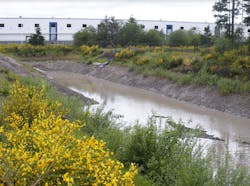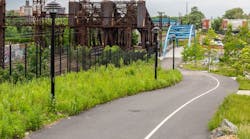Have you ever considered existing vegetation on your project site to be of value for an upcoming development project? While it is not indicative of typical interurban development, let’s take a closer look at what value a site’s existing vegetation has to offer.
Introduction
Natural vegetation can sometimes be a valuable best management practice (BMP) for managing storm water accumulated on a site. This includes management of qualified water relatively free of sediment and turbidity (i.e., below or within acceptable permit parameters) to extremely heavy-laden turbid water which would be considered an exceedance to a permit and violation to the Clean Water Act (CWA), if discharged offsite. Larger, surrounding sites of undeveloped land with grass fields or forested land may not be included in the initial proposed construction areas and could be phased.
Phasing work and clearing only the area(s) you plan to develop, along with maintaining and protecting the natural vegetation covered areas, reduces the area(s) requiring storm water management. Having vegetated land adjacent to a site or onsite provides the option to discharge accumulated storm water from the cleared and graded areas, dispersing it across the vegetated land. This process can be conducted by a conveyance system of pumps, distribution piping, sprinklers, spreader bars, etc.
This approach is important when compared to clearing the site all at once. Separating the phases as they are being developed would reduce the areas cleared of vegetation. Any cleared area requires installation of BMPS, as well as management of the areas and crews to ensure they are compliant with permit requirements. To save on mobilization charges, consider long-term costs versus the initial plan. Once you’ve experienced a site that requires extensive storm water management and the resources to comply with state and local municipalities, it is likely to be prioritized early in the planning phases of your next project.
Depending on the timing, duration and phasing of the project, the cost to remobilize crews to clear other areas of the site may be insignificant compared to the ongoing costs associated with storm water treatment system equipment rental and the required system operations and maintenance (O&M) performed by in-house personnel (if qualified) or a subcontracted consultant that specializes in storm water management. Depending on the project, the treatment of millions of gallons of storm water could potentially be required on a cleared site.
Considering the geographic setting and soil lithology, storm water can be contained onsite (temporary settling ponds, baker tanks), allowed to settle to allowable discharge standards, and then pumped offsite (where approved and permits are in order). In other situations, turbid storm water could take too long to settle before achieving acceptable parameters unless passed through treatment systems, which can be costly. Having the option to pump storm water into a vegetated area may prove to be beneficial and result in savings to a project that could have required treatment. It should be noted that it is typical in high-density urban settings to utilize treatment systems and while sometimes expensive, may be the only option for discharge.
Case Studies
A proposed commercial development was located within an area that shared a nearby offsite storm water retention pond that received storm water from neighboring commercial developments. The site included catch basins and subgrade storm drain lines where storm water was received and discharged into the pond. The site was not paved, and the catch basins were only surrounded by bare soil with minimal vegetation, which was not sufficient to effectively manage significant amounts of storm water. During development of the site, a few significant storms occurred and increased volumes of sediment-laden storm water entered the pond. The sediment and silt that discharged into the pond created a seal and prevented proper infiltration. To clean the turbid water from the storm water pond, the pond would need to be emptied before equipment could remove all the silt and sediment that had accumulated at its bottom. Costs associated with management and clean-up of the pond were not a budgeted expense. Some typical practices of pumping into a treatment system to produce qualified water to be discharged to surface waters of the state (i.e., through surface catch basin drains) can add up quickly.
This site was surrounded by nearby residential developments. On one side, there was an accessible vegetated strip of land that separated the site from the residential neighborhood. Instead of cleaning the turbid water located in the pond, this vegetated strip of land provided the option to install a conveyance system to pump the pond water into a large settling tank, which fed into a series of spreader lines placed within the vegetated strip. Once pumping began, the spreader lines were monitored for flow and adjusted as needed to prevent flooding of an area that could result in runoff from the vegetated area.
The vegetation acted as filter media, providing a level of absorption by the leaves and roots, in addition to the infiltration of the water into the soils. This process was used to pump approximately 500,000 gallons of water from the pond to allow for the cleanout.
Another site development located in a hilly urban setting required a portion of the site to remain vegetated. Therefore, piping and spreader bars were installed to allow pumping of turbid storm water from temporary sediment ponds into the vegetated hillside. While this was effective, flow rates were monitored closely after it was observed that, at increased flow rates, some of the water was flowing through the vegetation and back onto the site. Not all the storm water could be dispersed across the vegetated area; a BMP was used to manage some of the storm water during the beginning phases. A development for a large multi-level apartment complex was cleared of existing trees. This site was located on a hillside sloping down to a city pond. Between the site and the pond, the land featured wooded areas with dense undergrowth. Managing the turbid storm water onsite became a challenge for the earth workers during times of heavy rainfall, and the designated outfall for sites’ storm water discharged into the pond. Through a series of onsite collection systems designed to manage storm water from freely flowing offsite, the storm water was pumped into a conveyance system designed with spreader bars into vegetated areas between the site and the pond. To monitor the effectiveness of utilizing the vegetative cover as a BMP, the water in the pond receiving the discharge was monitored utilizing turbidity field equipment. If a sample identified an increase in turbidity, the conveyance system piping and spreader bars were adjusted within the vegetated areas. Over time, storm water with high turbidity can cause vegetated areas to become less effective in allowing filtration, absorption and infiltration of the storm water.
Take Away
As with any project, no two scenarios are exactly alike. Understanding the estimated amount of storm water that could be generated at a site during construction activities can increase awareness to the management of the storm water and resources necessary. Managing storm water is one layer to the process of development, and it is possible to plan ahead and have the right team prepared to manage costs while maintaining the project schedule.
About the author:
Eric A. Dubcak, CESCL is a group manager for Terracon’s Seattle office. Dubcak can be reached at [email protected].






